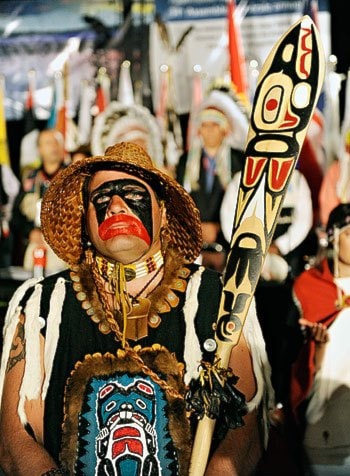The Indian Act is outdated, paternalistic and it needs to go, according to many of the chiefs gathered at Assembly of First Nations meetings in Whitehorse this week.
But what should Canada’s First Nations replace it with? What are the first steps? How does one even go about replacing a document that has guided the Crown’s relationship with indigenous Canadians for almost 150 years?
As former Council of Yukon First Nations grand chief Ed Schultz tells it, you have to start with educating the people.
“You can chart all the plans you want. You can have all the framework agreements you want, all the law-making you want, until you build a library. But if there’s only a handful of people in your community that can read and understand those things, it doesn’t mean a thing,” Schultz said.
Ensuring that First Nations citizens have a solid grasp of western education is important, he said, but maintaining a strong cultural identity is equally vital.
“Building capacity means building capacity in your people,” he said.
Schultz was one of five leaders who spoke about the challenges of moving past the Indian Act at the Assembly of First Nations annual meeting on Tuesday.
Schultz said one of the biggest challenges he encountered was convincing people to let go of a document that they had gotten used to, despite its ineffectiveness.
“First of all, like all human beings, our people were accustomed to the act, despite its shortcomings. People become accustomed to any environment, no matter how ugly things get,” Schultz said.
Just talking about replacing the Indian Act is the first step, he said, but even that is hard and change is scary.
“We had to get our people to make a mental change in how they saw themselves.
It’s not an easy transition. It’s hard. All those people who were accustomed to how it was, no matter how bad it was, just like a bad marriage. They couldn’t make the change.”
The solution, he said, is to start with building a constitution that is written by the people and approved by them. But in order to do that, you have to help build up the people.
British Columbia’s Westbank First Nation Chief Robert Louie also spoke at the panel. His First Nation is one of the most successfully developed in the country, and it’s all thanks to an agreement that was negotiated in 1996, he said.
While the Yukon was working on the Umbrella Final Agreement, Westbank was putting in place the Framework Agreement on First Nations Land Management. Despite its unwieldy title, it is a framework that’s worth examining and learning from, Louie said.
The agreement was first negotiated in 1996, and had 14 First Nations sign on. It was a big first, and ensured that the federal government couldn’t unilaterally change the agreement without the consent of the signed First Nations.
“That is historic. That was the first time in history that a meaningful statutory alternative to the Indian Act had been accomplished,” Louie said.
Westbank owns strip malls, tourist attractions and is a partner in a successful golf course. The community has its own forestry management program to harvest lumber from its lands, and it is currently working towards building a $180-million integrated health-care facility that will be capable of providing everything from heart operations to hip surgeries.
And they’ve developed all of it sustainably on their own terms, guided by the principles of self-determination, he said.
Now there are 84 signatories to the framework, and another 68 First Nations on a waiting list to join as well.
And it’s not just working for Westbank. Every dollar invested in that community generates $10 in return, and that benefits all Canadians, said Louie.
“We have proven, as First Nation peoples, that we are a definite benefit to the economic situation in Canada. We are pumping hundreds and hundreds of millions of dollars into local economies.”
As important as formalizing agreements with Ottawa is, First Nations shouldn’t forget to learn from and trade with each other, said Grand Chief Michael Mitchell, of the Akwesasne Mohawk Nation.
“Don’t just listen to Ottawa. Don’t just listen to the province. Listen to other First Nations that have gone through it,” Mitchell said.
The Akwesasne Mohawk Nation’s traditional territory straddles the U.S. border. Mitchell said he sees a marked difference in how his people are treated by the American government, and he’d like to see the same from Canada.
“When you get a letter from the White House, it always says ‘Greetings, to the leaders of the Mohawk government.’ They preface everything with words like ‘sovereignty.’ Do bands in the U.S. have real sovereignty? No. But they have a lot more and it’s better appreciated than here in Canada,” Mitchell said.
The AFN annual meetings run until Thursday at the Coast High Country Inn in Whitehorse.
Contact Jesse Winter at
jessew@yukon-news.com
